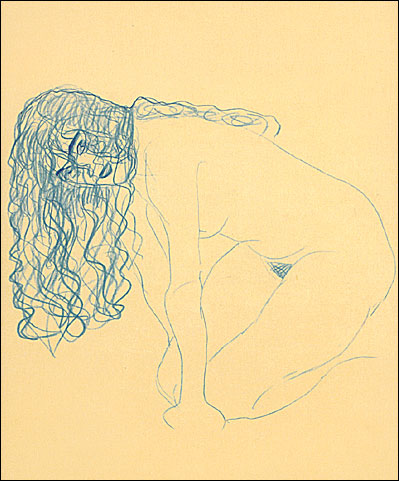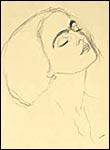
Gustave Klimt. Nude model crouched up, looking through her hair, circa 1907, blue pencil
on paper, 37.2 x 56.5 cm. Wien Museum, Vienna
Cliché Fotostudio Otto, Vienna-© Direktion der Museen der Stadt Wien |
|
FONDATION DINA VIERNY MUSEE MAILLOL
59 - 61, rue de Grenelle
75007 Paris France
INFORMATION:
Tel : 01 42 22 59 58
Fax : 01 42 84 14 44
Site : www.museemaillol.com
E-mail : contact@museemaillol.com
HOURS:
Everyday, except Tuesdays
from 11am to 6pm
Last admission 5,15pm
PRICES OF ADMISSION:
Normal Price: 8 €
Reduced price: 6 €
Free under 16.
CURATOR:
Caroline Messensee
PRESS CONTACTS:
i&e Consultants
Claude Unger
Elisabeth Apprédérisse
Tél : 01 56 03 12 25
Fax : 01 56 03 13 00
E-mail : cunger@i-et-e.fr
eapprederisse@i-et-e.fr

|
Klimt the drawer and Klimt the painter sometimes seem like two very distinct persons. The painter is the one we know, the intellectual bourgoisie's official artist from the joyful Viennese Apocalypse, the author of somptuous works of art exemplary in the use of ornament. He is above all a painter of commissions, whether commissions from the State in his beginnings, or private commissions from wealthy men who wished to make their women’s beauty eternal. The drawings of portraits that we know do not seem to have been major pictorial creations but rather to have played the part of an accompanist. And yet Klimt is above all a drawer.
The most intimate part of Klimt’s work
While his large pictorial works are painted to be seen, the works on paper were on the contrary never meant to be shown to the general public, even though the rare critics and connoisseurs who were able to access his workshop believed they were the best part of his creation. It is in this sense that “Erotic Papers”, by bringing together for the first time 120 drawings of exceptional quality around the unique and inexhaustible theme of the nude and eroticism, is a great event that unveils the most intimate part of the artist’s work
Woman totally available sexually
n his drawings Klimt escapes the temptation of colour. Form is his aim above all and it leads to the quintessence of his art. The drawings are free of any decorative motives in which the figures disappear, as if absorbed by an abstract framework. Klimt knows how to create a completely uninhibited atmosphere. In the words of Hofman he knew how to paint woman in her distant dignity and to draw her in her total sexual availability. There are many drawings in which the young girl lets herself be carried by her pleasure. She is shown lascivious, her eyes closed, sketched with the point of a pencil that is so thin that her body seems to disappear into the emptiness of the paper. There is no need to bring forward the erotic aspect of the scene. Klimt limits himself to express the sign of pleasure by an extra line on her eyebrows, that suddenly sticks out like a drawing in the drawing, underlining the sensations that lead her beyond herself.
No mask nor public
In no other aspect of his work is Klimt as close to himself. In his drawings he is without a mask, without a public, without a collector. He draws only for himself. His drawing is liberated of all conventions, of all restrictions and its only demand is that of its creator. It is the instantaneous translation of the creative shock the artist undergoes when he sees and works with his model or models. The extraordinary freedom of the line that characterizes his works allows him to reach a representation of desire without the need to justify his nudes by anything else but the mystery of the desire, where the nude and eroticism combine for one same purpose.
Illustration: Woman’s head, eyes closed, 1913, pencil on paper, 55.9 x 36.5 cm, private collection.
PUBLICATION
Exhibition catalogue. Texts by Jean Clair, Werner Hofmann and Caroline Messensee. All works in the exhibition are reproduced in colour, 23 x 28.5 cm, 192 pages. Coedition Musée Maillol/Gallimard, paper back 35 €
|









